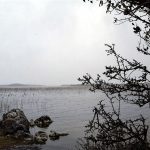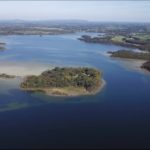In spite of a biting wind and threatening storm there…
The marl crusts of Lough Carra
The Lough Carra Catchment Association has supported the publication of ‘The Marl Crusts of Lough Cara’ by Philip Doddy. This booklet highlights some of the features that make this lake so unique…
Take a wander along the shore of Lough Carra and you will surely see many things of interest – the beauty of the landscape, a bird dabbling in the water, bright patches of wildflowers, maybe a few sheep quietly grazing in a nearby field. Another thing you might notice is that the rocks along the lakeshore are covered with a curious, whitish, quite slippery layer. This is a marl crust.

What are marl crusts?
If you cut a slice of marl crust and look at it closely, you’ll see a green layer just beneath the surface. Below this will be a soft, whitish, crumbly layer, made up of quite fine grains. A magnified view of the green material shows that it contains many living things – a community of tiny life forms. The majority of these are cyanobacteria – ancient organisms which can grow as filaments, clusters of cells, or interwoven masses, depending on the species. Cyanobacteria have been around for billions of years; indeed some of the earliest traces of life on Earth are micro-fossils of cyanobacteria.
Various algae can also be seen in the living layer of marl crusts, along with microscopic animals such as nematode worms. Bigger animals live in these crusts too. Because thick crusts often have cavities or hollows, animals such as beetles, flatworms, and caddis fly larvae can be found living in them. A water spider will often emerge from a piece of crust if you examine it closely. A particularly rare beetle, called Ochthebius nilssoni, has recently been found living in Lough Carra crusts.
As well as these living creatures, marl crusts contain a lot of small grains of calcium carbonate (the main mineral that makes up limestone). In the upper layers of crust, these grains are bound together by many strands of filamentous cyanobacteria. This is why crusts have a firm texture. These grains also form the whitish material towards the base of the crusts. Because cyanobacteria need light, they cannot grow very deep within crusts, and so the lower parts of crusts are more loose and crumbly in texture.
Philip Doddy
Learn more:
The marl crusts of Lough Cara is available to download online: www.lifeonlimestone.weebly.com/marl-crusts-booklet.html
Doddy, P., Roden, C.M. & Gammell, M.P. (2019) Microbialite crusts in Irish limestone lakes reflect lake nutrient status. Biology and Environment: Proceedings of the Royal Irish Academy Vol. 119, No. 1, 1–11.








